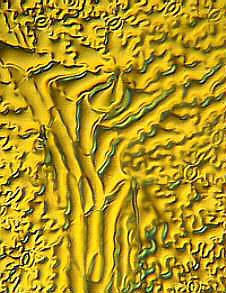
The epidermis is the main dermal tissue of primary plant organs above ground. It covers the shoot, leaves, flowers, fruits, and seeds and serves several functions. Among them are protection from water loss, against physical and chemical influences and from feeding by animals, as well as participation in gas exchange and secretion. Special cells or devices for some of these functions developed during evolution. Light and mechanical stimuli are perceived by specific receptors, the perceptors. The stoma complexes are scattered across the whole epidermis and act as sites of gas exchange between leaf and atmosphere. Stoma complexes consist of several cells. Two guard cells that enclose the actual stoma, a pore in the epidermis, control its state of opening. They are supported by two or more subsidiary cells. The cuticle, a structure that is secreted by the epidermal cells and covers them like an uninterrupted film helps to prevent water loss. This is also a purpose of the trichomes, epidermal hairs. But not the only one. Trichomes function as devices against animals, as glands, as weapons or water vesicles, too.
Another dermal tissue is the rhizodermis, which covers all underground plant parts. Its main feature are the root hairs. They enhance the plant's surface and consequently also its ability to absorb enormously. Cells of the rhizodermis secrete a mucilage, that generates a rhizosphere, whereby absorption is further contrived.
Older shoots and roots have normally gone through secondary growth. Their primary dermal tissues are replaced by a secondary dermal tissue, the bark. The bark is produced by the phellogen, a secondary cambium, and is interspersed with groups of cells called lenticels. The lenticels have the same function as the stoma complexes in leaves: they are sites of gas exchange.
Ground tissues make up the bulk of all tissues. All specialized cells are embedded in them. The cells of the ground tissue are the parenchyma cells. Parenchyma cells have assimilation, storage- and wound-healing functions. Parenchyma tissues are the mesophyll, an important assimilation tissue, the palisade parenchyma and the spongy parenchyma of leaves. Further leaf structures are the vascular bundles and their bundle sheats. A specialized way of carbon dioxide fixation is performed by a wreath of cells that surrounds the bundle sheats of C4 plants, the Kranz anatomy. The development during ontogenesis determines the leaf's shape. Its growth takes place in wave-like growth movements.
|
|